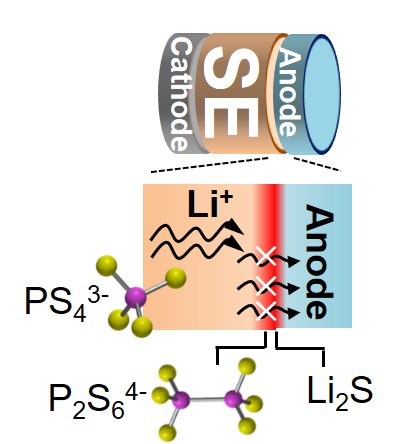The substantial growth of energy demand request safe, largescale, and reliable next-generation energy conversion and storage systems. The next-generation energy conversion and storage devices are commonly made of solid materials for improved device safety and long-term stability. The molecular structural change at the interfaces between solid materials in these devices significantly impact the device performances.
The Sang group is broadly interested in fundamental chemical processes at the interface of energy devices, e.g. batteries and solar cells. Perturbations (temperature, radiation, electrical potential etc.) during characterization allow us to interrogate the correlation between molecular structure and device functionality.
We are at the interception of analytical, materials and interfacial chemistry. Our research tools include vibrational spectroscopy (Raman, IR), X-ray spectroscopy, electrochemistry. We develop arrange of in-situ measurement tools (in-situ Raman, XANES, tomography) to answer materials chemistry questions.
Theme 1: Control the Electrode/Electrolyte Interfaces for All-Solid Batteries

All-solid batteries potentially offer enhanced energy/power density and improve battery safety. Degradation at the solid electrolyte (SE) and electrode interface, however, hinder the battery cycle life. Theme 1 focuses on understanding the origin, transformation, and the fate of the SE/electrode interfacial layers during battery processes.
The figure on the left shows an example of the decomposition chemistry occurred during Li/Li+ redox chemistry measured by in-situ Raman spectroscopy and X-ray photoelectron spectroscopy.
Theme 2: Understanding the Hysteresis of Perovskite Solar Cells
 As an emerging technology, organic-lead-halide based perovskite solar cells (PSCs) achieved comparable power conversion efficiencies (PCEs) to commercialized Si-solar cells while being compatible with cost-effective large-scale solution processing. The poor inherent stability of perovskite is the greatest hurdle for producing scalable PSCs. Photocurrent hysteresis often observed in PSCs. i.e. the current-voltage (J-V) behavior strongly associated with the scan rate and bias direction, and discrepancies are often found between the initial scan and measurements after holding the device at a certain bias. In theme 2 the group will develop in-situ measurement tools to analyze the interplay of perovskite/oxide electrode interfacial chemistry in the photocurrent hysteresis.
As an emerging technology, organic-lead-halide based perovskite solar cells (PSCs) achieved comparable power conversion efficiencies (PCEs) to commercialized Si-solar cells while being compatible with cost-effective large-scale solution processing. The poor inherent stability of perovskite is the greatest hurdle for producing scalable PSCs. Photocurrent hysteresis often observed in PSCs. i.e. the current-voltage (J-V) behavior strongly associated with the scan rate and bias direction, and discrepancies are often found between the initial scan and measurements after holding the device at a certain bias. In theme 2 the group will develop in-situ measurement tools to analyze the interplay of perovskite/oxide electrode interfacial chemistry in the photocurrent hysteresis.
The figure above demonstrates the two hypotheses of photocurrent hysteresis. (J-V curve is cited from B. Chen, J. Phys. Chem. Lett., 2015, 6 (23), pp 4693–4700 and B. Chen, et al. J. Phys. Chem. Lett., 2016, 7 (5), pp 905–917).
